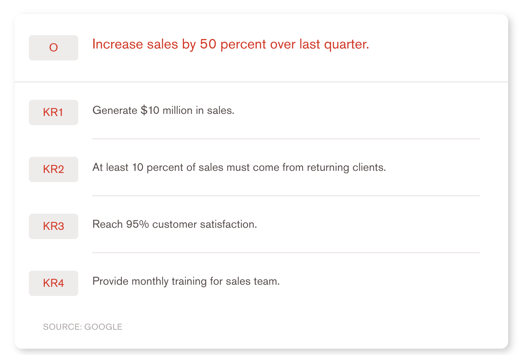Matteo Bizon is a PPC Specialist at Bobsled.
Instacart Advertising: Deep-Dive into OKRs (Part 2 of Instacart Advertising: Measuring What Really Matters)
Two weeks ago, Bobsled experts introduced Objectives and Key Results as a helpful technique for measuring KPIs on Instacart. Brands that are already successful on this platform typically choose to hone in on a few specific Objectives that will more clearly inform their goals.
When assessing its goals, a brand can determine whether it is a better move to support growth or profitability. Each comes with its own set of OKRs that can help facilitate success down the line. Growth is mostly achieved through the increase of a brand’s market share; this is tightly connected to that brand’s ability to increase advertising efforts in order to see incremental results. Profitability, on the other hand, is achieved through high customer LTV and strong TROAS overall.
Today, we are going to focus on some of the main KPIs and factors that influence growth or profitability for brands on Instacart.

This framework has been developed by analyzing key levers that we typically utilize to drive results for our clients at Bobsled. By studying all of the main metrics that we could possibly get data on (both through Instacart directly and by using third-party tools that integrate with Instacart, such as Pacvue), we were able to discover some important cause-effect relationships that can determine which metrics should steal a brand’s focus. It is also imperative to measure how these metrics can be better controlled and improved.
This is the type of analytical approach that we like to apply to advertising as an omnichannel brand agency. We strive to be as data-driven as possible to help our clients meet and even exceed their business objectives.
Let’s jump into these specific Objectives and Key Results now!
Key Placements
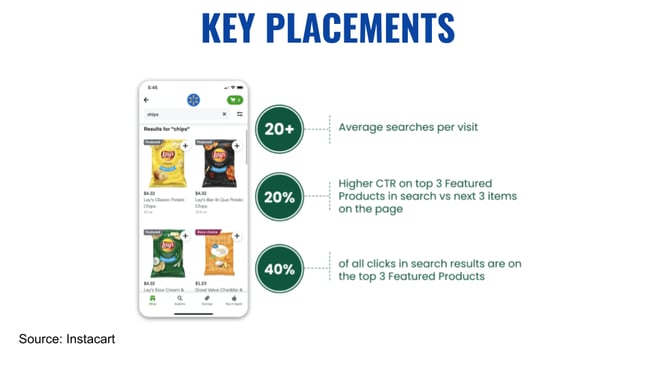
The more you bid for a keyword - and the longer you remain competitive - the higher chances you have of appearing at the top of the page. Some brands are willing to pay for a specific user to visit their product pages in order to gain more search result hits.
Quick Review: Placements on Instacart
In order to really understand the ways in which the following information will be beneficial to brands looking to grow on Instacart, it’s important to take a step back and review some of the basics. Particularly, it is crucial to focus on the data that goes behind ad placements on Instacart.
Typically, Featured Product ads are placed at the top of the page, even before organic search results show up. They can also appear throughout the page mixed in with organic results. Instacart’s own research has shown that 40% of all clicks in search results come from the first 3 ad placements - and that is true for any search results page on the platform.
Understanding these concepts, we will analyze more metrics in detail while going over a few scenarios that influence a brand’s main goals of growth or profitability.
Market Share Budget Management
In order to really understand the ways in which the following information will be beneficial to brands looking to grow on Instacart, it’s important to take a step back and review some of the basics. Particularly, it is crucial to focus on the data that goes behind ad placements on Instacart.
Typically, Featured Product ads are placed at the top of the page, even before organic search results show up. They can also appear throughout the page mixed in with organic results. Instacart’s own research has shown that 40% of all clicks in search results come from the first 3 ad placements - and that is true for any search results page on the platform.
Understanding these concepts, we will analyze more metrics in detail while going over a few scenarios that influence a brand’s main goals of growth or profitability.
Market Share Budget Management
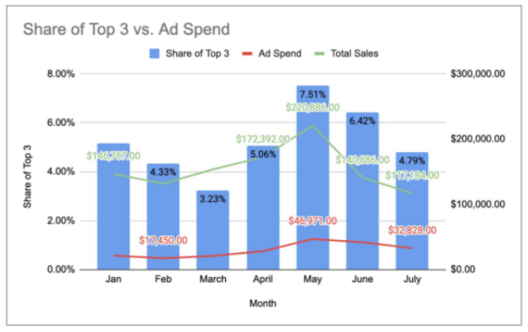
Let’s discuss some of the specific factors that influence a brand’s ability for growth. The above chart represents one of our Bobsled clients and their ad spend performance over time. It also counts total sales and top 3 ad placements statistics. This particular brand is in the food industry selling ready-made meals using plant-based ingredients. Its main goal is to grow its market share.
Take a particular look at the relationship between the available budget and total sales. Incremental advertising on Instacart is usually determined by a combination of search volume and store distribution. If a market category contains the right level of advertising incrementality, a brand’s growth in that category is only limited by its level of ad spend.
What’s the Point?
By having an appropriate budget, we were able to achieve the following goals with this client:
- Their brand campaigns did not exhaust the daily budget, especially not early in the day while going dark later on. This system ensures that the best placements aren’t left to the competitors.
- By being more assertive with our bids, we were able to stay more competitive when bidding for the most important placements that grew visibility and traffic.
Action Items
Any brand looking to achieve growth on Instacart should spend some time focusing on how to achieve the greatest number of impressions and clicks while simultaneously working to win over their competitors. This can be achieved by strong bids across the board for the best chances of winning top 3 placements.
Important note: Some brands feel taken aback when they log into their ad console and see how aggressive the bids are that we set for them. But remember that Instacard works on a 2nd price auction model, meaning that we only pay $0.01 more than the second strongest bidder - which usually does not reflect the actual bid that is set.
Clearly, budget is a very important factor. For most brands, this is not an unlimited resource, so it’s important to identify the keywords for which it is absolutely critical to dominate search results and apply the highest bids.
Market Share with Increased SOV Analysis
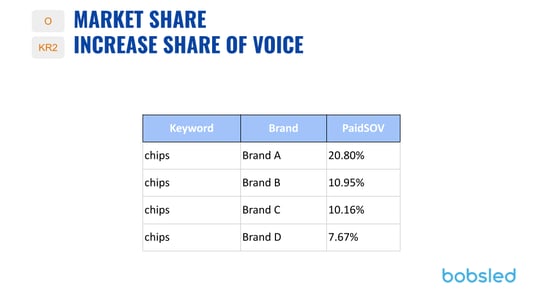
Another growth-related key result we want to analyze is an increased Share of Voice. In order to achieve this desired growth through advertising, we should have ads being pushed out on a consistent basis. Not only that, they should be in better placements than those of the competitors. The best way to keep an eye on this is to run a Share of Voice analysis every so often.
We achieve that at Bobsled through a strong partnership with Pacvue, an incredible reporting and optimization tool that integrates directly with Instacart’s advertising platform. It can pull some great data for brands to use to their advantage.
A Share of Voice analysis is conducted when brands select keywords that they want to be automatically tracked through the system. Pacvue then monitors these queries and can then tell a brand how many impressions they are winning compared to their competitors. While this doesn’t translate directly into tracking the sales volume of other brands, it is a great indicator of advertising presence on Instacart. This ultimately compares to overall sales volume.
What’s the Point?
By looking at the table up above, it is easy to see what kind of results can be returned by Pacvue. For each keyword, Pacvue is able to determine the competing brands and their “real estate” in terms of impressions (both organic and paid).
Using this specific client example, you can see that the data in the keyword and brand column has been anonymized. However, paid SOV data points come from the different analyses run for our clients. Using a broad keyword with high search term volume is a key strategy for helping the product earn more growth.
Our brand was in position C, giving us the same result as Brand B. This is what made us decide to increase our efforts when fighting for specific keywords. After a month, we surpassed Brand B by 3%, overtaking the second position.
Action Items
It is very important to understand how our brands are performing compared to their competitors on specific keywords. This will guide our actions as far as PPC strategy goes on Instcart and beyond. As an example, we might see that a crucial keyword has a low SOV analysis. The solution is to delegate more of the budget to overcome that keyword and become more aggressive with bidding.
Comparing the Approaches of Growth Vs. Profitability

So far, we’ve talked about how important it is to carry a strong bid while balancing the right kind of budget for growth. Now, let’s compare two different scenarios that will serve as an example of the different types of approaches we need to use depending on our ultimate goal: growth or profitability.
What’s the Point?
This table talks about the performance of two different tea brands in using major advertising KPIs over a set period of time. These two brands are owned by the same company, and Bobsled is currently managing both accounts.
Brand A and Brand B operate in the same category but have vastly different characteristics, goals, and needs. Brand A is a more mature brand with an established and healthy distribution network. This brand’s focus is to use Instacart to reach shoppers to increase profits. Brand B, on the other hand, is a newly-launched client with a young distribution network. For comparison, only 5% of the distribution is in stores compared to Brand A. It’s obvious that the main goal here is awareness, visibility, and initial growth.
Take a look at the last column of the chart that shows CPC values. These are all directly related to the aggressiveness of the bids that the two brands show in their campaigns. Brand A cares more about profits than growth and therefore can bid a little less aggressively and pays about $0.80 per click with a final ROAS of 4. Brand B is still trying to achieve growth and needs to focus a lot more on impressions than Brand A. With a weaker distribution network, available impressions are just lower. Brand B needs to make extra sure to win as many auctions as possible. This is best achieved through a more aggressive bidding strategy. Still, the ROAS is much lower with an average of 1.3 over this time period.
The Results
The results were nothing short of amazing. By calculating the proportion of the two brands’ distribution networks and applying it to the impressions, the outcome shows that Brand B should be able to achieve half a million impressions. By being even more aggressive, we were able to exceed this projection by five times. This way, we were able to meet the clients’ expectations of reaching more initial awareness and sales.
Action Items
Again, the takeaway from this analysis is to understand the importance of making the right bids - and making them aggressively - in your campaigns. If the main goal is growth or visibility, then brands should prioritize winning premium ad placements and getting the most impressions. On the other hand, a client looking to increase profitability will have to trade visibility for ROAS by applying lower bids.
CLV Repeat Purchase Behavior
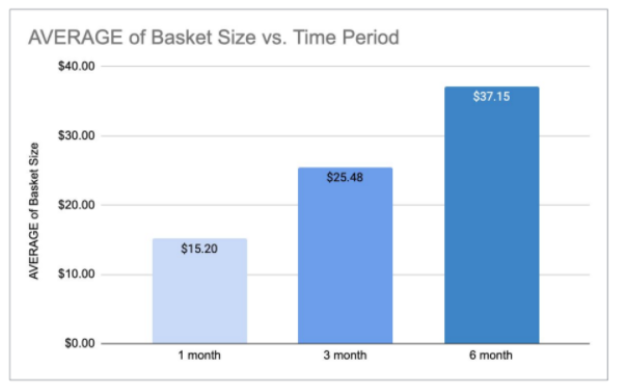
It’s time to focus on a scenario where profitability is the main and sole objective. There are many ways to increase profitability on Instacart, and different strategies are recommended for different brands. Overall, a good way to increase profits on Instacart is to raise overall LTV: lifetime value.
What’s the Point?
The chart up above displays the value of an average basket size for a brand after 1, 3, and 6 months after the customer made a purchase. The point of this analysis is to measure the basket sizes for specific brands, using values that are different based on that brand’s needs and goals. Each product and brand represents a different type of repurchasing behavior, which all need to be assessed separately.
Over time, these values will grow and result in a new revenue stream for this brand.
Action Items
To achieve high profitability, it is important to maintain our customer loyalty and increase their repurchase rate. To avoid losing customers, defensive campaigns should be set up in the Instacart advertising console. Anyone who has liked a brand’s products and remembers a brand’s name will be very likely to use the brand again in the future.
Since Instacart doesn’t restrict competitors from bidding on branded keywords, it is crucial to run a campaign that protects first ad placements associated with those keywords. Using this method, brands can benefit from higher conversion rates and retaining repeat customers to determine profitability over time.
Important note: Instacart launched a new campaign type called “display ads” late last year. For now, it is only open to a few select brands to test out the campaign, but it will most likely be available to everyone by the end of Q2 2022. Display campaigns take up banner ad space, appearing at the top of the search results page.
These campaigns can be set up to target people based on either their keyword type or their search behavior. As an example, one option allows brands to target customers who have purchased from them in the past. This will end up being an incredibly useful tool in supporting high conversion rates.
Comparing the Campaign Goals of Growth Vs. Profitability

Let’s review different types of display campaigns based on a brand's ultimate goal: growth or profitability. Both types of campaigns are targeting audiences based on certain customer behaviors.
Campaign A is focusing on racing people who shop regularly in particular aisles or departments but have never purchased from the brand itself. Campaign B is solely focused on driving up repurchase value.
Campaign A has a lot more money to spend because they are looking to reach a very wide audience; plus, the conversion rate is not very good, which can affect the total ROAS of the campaign. These brand-new customers and low ROAS are both prices that must be paid in order for the brand to achieve consistent growth.
Campaign B, on the other hand, is aiming for profitability. They will likely spend less than Campaign A since the number of people who have bought from the brand is smaller than the total pool of impressions in a given department. That is why this particular campaign will focus on driving up the repurchase rates, which will show incredible results in terms of ROAS.
Action Items
Working with hundreds of brands across a variety of retail media channels, we have learned that there is always going to be a trade-off between profitability and growth. Brands cannot work to achieve both at the same time, at least not on the same ad platform and with the same products.
Brands should be aware that every campaign has its own set of results based on the overall goal, and this is directly linked to the overall approach that the brand needs to take when setting its advertising strategy. In Bobsled’s experience, and from the data we’ve gathered, it’s clear that advertising campaigns just can’t bring home two results at once. Those days are long gone! So, when considering goals in the future, it is important to focus solely on growth or profitability while understanding that there are a few consequences necessary to meet those goals through Instacart advertising.
What Should Brands Do Now?
There are a few things that brands can do to get started in creating a goal-focused ad campaign on Instacart. We’ve broken them down into three main points:
- Identify Objectives for each product, brand, and shopping channel. This is one of the most crucial points and the number one area where we see brands fail since they aren’t clear on what the goal is. Brands cannot be vague with their goals and then feel disappointed when they have outstanding profitability but low SOV, for example.
- Identify Key Results that are sensible, coherent, and actionable while in line with the key objectives. Unfortunately, the most legible metrics are those that get the most focus. But brands should consider that Instacart puts specific metrics front and center that are either the easiest to produce or the most sought-after. This does not mean they are necessarily the right metrics for every brand. It’s okay to be a bit choosy when it comes to KRs, focusing only on those that really matter.
- Educate everyone in the brand about what eCommerce professionals can do to stay in line with these goals. Look back at the OKR cheat sheet that we shared in Part 1 of this blog post and look over the examples posted above to build a solid foundation for successful ad campaigns on Instacart.
Want to build your own custom OKRs to drive growth or profitability?
Get in touch with our Bobsled experts today!
The first part of this blog was published on 28 July 2022.
Like other major eCommerce platforms, Instacart’s advertising features and metric tracking priorities have changed in 2022. However, a lot of fundamentals remain the same over the years - particularly when it comes to what it takes to track important business elements and act on them. This was the focus of our latest Instacart Advertising Webinar, from a few months ago, which helps brands garner success on Instacart by tracking the most important objectives and results.
Source: Amazon
It's easy to be distracted by the most obvious, easy-to-track metrics on your Instacart advertising dashboard. But which metrics should your brand be focusing on?
The most successful brands on Instacart choose to focus on a handful of overall business Objectives to paint a clearer picture of the company’s eCommerce goals. Then they use these objectives to help them identify which Key Results will best achieve those objectives.
Below, you’ll find our cheat sheet of Key Results on Instacart, which business Objective they relate to, and a description of the factors influencing them. This is based on Bobsled’s experience managing Instacart advertising for dozens of consumer brands.
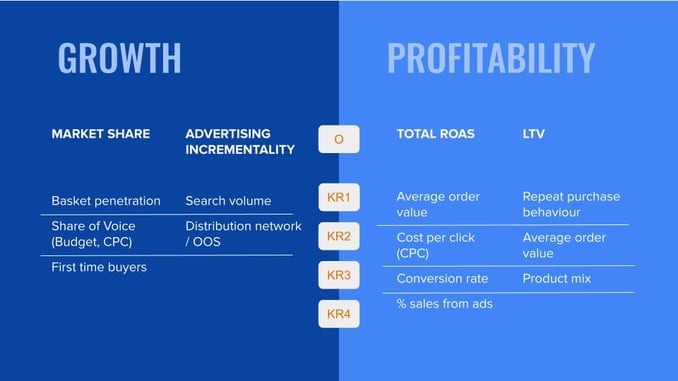
Objectives and Key Results, Explained
In Measure What Matters, John Doerr builds a strong case for Objectives and Key Results - otherwise known as OKRs. There are plenty of great tools available to use in order to follow along with this approach, which also comes with actionable advice and many solid examples of this idea seeing success today.
Objectives
Objectives define WHAT you want to achieve. According to Doerr, “Objectives are significant, concrete, action-oriented, and (ideally) inspirational”. They should always encapsulate the core values and goals for you to always focus on above all else.
Key Results
The key results help you figure out HOW you are going to achieve your strong objectives. Doerr says that the best Key results are “specific and time-bound, aggressive yet realistic. Most of all, they are measurable and verifiable”. With good key results, there can be no room for doubt. They effectively monitor and benchmark the methods of achieving your objectives.
OKR Example
Some brands have trouble distinguishing between Objectives and Key Results when trying to plan growth and profitability goals for the long term. Here’s an example to set these definitions into stone:
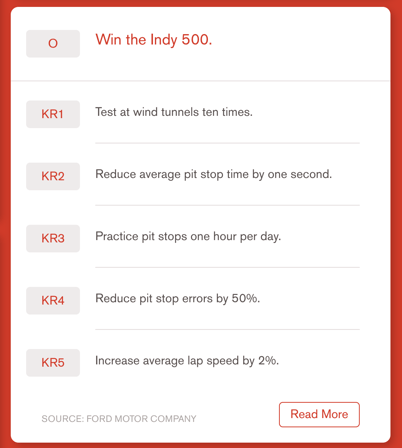
As you can see in the image above, there is an Objective and 5 Key Results. Keep in mind that Key Results are not just a series of steps to achieve the objective. They do not necessarily outline a plan that should be set in motion, but rather a collection of inputs (processes) and outputs (the result of those processes).
With the example Objective to “Win the Indy 500”, one Key Result is to “Reduce pit stop errors by 50%”, which is an output of a process. In this case, the process is skill improvement and driver growth. Another Key Result is to “Practice pit stops one hour per day”, which is an input, or process.
Key results are, to the best of the brand’s knowledge, the best ways to achieve the ultimate Objective.
Take a peek at this second example and see if you can identify input KRs and output KRs while you familiarize yourself with the overall OKR formula.
Growth Vs. Profitability
When trying to develop growth and profitability Objectives, a lot of sellers may conflate key terms and definitions. Growth itself is not a strategy, so it is important to create an Objective that can steer your business towards growth in a way that works best.
Our Bobsled experts might recommend that a brand simplify its commercial Objectives by placing them in one of the two biggest categories: growth or profitability. There can be additional Objectives as well, but most generalized Objectives can be related back to these two major types.
Again, growth and profitability should be the two major Objectives of any brand on any online platform.
Considering the Trade-Offs
Something we have learned at Bobsled over the years is that there are many trade-offs between these two major Objectives - especially when it comes to advertising performance. We like to think of it as a pair of scales: one directly affects the other. As an example, if you want to pour your resources and goals into growth, you may have to sacrifice some of your profitability needs. Below-the-brand advertising can expand your reach, but profits might take a hit.
Bobsled Clients Already Know
Some of our Bobsled clients and prospective clients ask us if we can increase their ROAS to a specific number. While we can certainly do this to promote profitability, it may not bode well for other Objectives and goals you have put into action. Clients looking for a ROAS of 20 can achieve that when we bid on high-intent, long-tail branded search terms. On the other side of the coin, this attracts no net-new customers which means that the brand will not be seeing much growth at all while this strategy plays out.
What About Profitable Growth?
You can choose to invest in both growth and profitability at the same time, but your results may be diluted across both categories. For the most part, it may be a better idea to spend brand advertising efforts on one type of Objective at a time.
Another question our Bobsled marketing pros get a lot is whether or not there can be a different type of Objective across channels and assortments. There absolutely can! Launching new sub-brands typically fall under the category of growth Objectives. On the other hand, cash-cow products in assortments will aim for higher profitability. This can be applied to emerging vs. existing channels as well.
Growth Objectives
Using the OKR process, we can now define major growth objectives for brands investing in Advertising on Instacart. Take another look at our KPI cheat sheet and follow along with these OKRs:
Objective: Grow Market Share
Market share is calculated as the certain percentage of company sales compared to the overall share of sales in its industry over a certain amount of time. This is a good Objective for those looking to accommodate markets that are rapidly growing, or more specifically defined. It can also be designed specifically around Instacart as an online channel.
Key Results for Growing Market Share:
- Basket Penetration is a metric that Instacart often uses to determine the value of top-selling products at all times. It is calculated by the percentage of baskets on Instacart that contain your brand’s product(s).
- Share of Voice (SOV) allows you to assess how much space your products take up in search results. This doesn’t show actual sales, but it is a good way to measure impressions. There are a few factors that can affect a brand’s SOV, such as the advertising budget and bid levels.
- First-Time Buyers should always be targeted by brands looking to facilitate growth.
Objective: Advertising Incrementality
Advertising incrementality measures your brand’s ability to scale advertising results. There is a problem unique to Instacart where brands can’t directly control their inventory position. This could mean that incremental growth is more challenging for brands that don’t have a wide area of retail distribution. Even brands that bid aggressively might not be able to increase impressions as quickly as they would like. Just like with the previous Objective, a brand’s advertising budget could also come into play.
Key Results for Advertising Incrementality
- Retail Distribution Networks and inventory availability should be a top priority for brands looking to achieve this Objective.
- Search Volume may be driven by outside macro factors like category growth or channel growth. They can also be affected by organic or paid efforts to grow a brand overall.
Profitability Objectives
Profitability objectives help you increase your bottom line while staying true to goals that will prioritize profits over growth. In our experience, total ROAS and LTV are two of the biggest profitability goals for brands of all sizes.
Objective: Improve Total ROAS
Also known as Return On Advertising Spend, your ROAS includes everything that is generated organically as well as through paid advertising budgets. This is the ultimate metric to plain ROAS when looking for complete results. This Objective can help give you a wider view of how a brand’s advertising strategy affects its overall performance on the platform. Not to mention, most brands are trying to hit a specific profit margin target on Instacart. TROAS (Total Return On Advertising Spend) makes it so much easier to calculate this profitability.
Key Results for Improving TROAS
- Average Order Value (AOV) is an important metric for improving TROAS. You can increase your average order value by optimizing landing pages and product pages for easier shopping experiences. Reducing cart abandonment rates can also help.
- Cost Per Click (CPC) is a great metric to measure overall and can be especially helpful in directly controlling your profitability.
- Conversion Rates will ultimately result in a higher TROAS.
- Percentage of Ad Sales will give you a good idea of your organic profitability vs. the net worth of your ad expenditure.
Objective: Increase Lifetime Value (LTV)
Consumable products sold on Instacart often guarantee repeat purchases. It’s important that brands know how many times a single customer returns to keep buying products over the course of their life. That is why a customer’s worth is known as LTV, or Lifetime Value. This is used to determine how much money, time, and resources should be spent on acquiring a new customer.
Key Results for Increasing LTV
- Repeat Purchase Behavior is the biggest indicator of a customer’s LTV and directly impacts these values on Instacart.
- Average Order Value can determine what is being purchased on a repeat basis and whether those products are valuable enough to contribute to LTV.
- Product Mix and Catalogue Size both play a part in increasing a customer’s lifetime value. This can include bundles, pack sizes, and halo products.
Get Your Own OKR Cheat Sheet!
Want to download this blog as a PDF cheat sheet to help you track your brand’s OKRs? Click here!
Next week, we will go into further detail about specific OKRs that brands should be measuring in order to improve growth and profitability through Instacart. Learn about what influences a brand’s ability to grow and see some critical examples of growth vs. profitability to see what Objectives and Key Results will work best for you moving forward!
Book a FREE consultation with one of our experts today!

Tagged: PPC Advertising, Instacart, Bobsled Marketing
.png)

